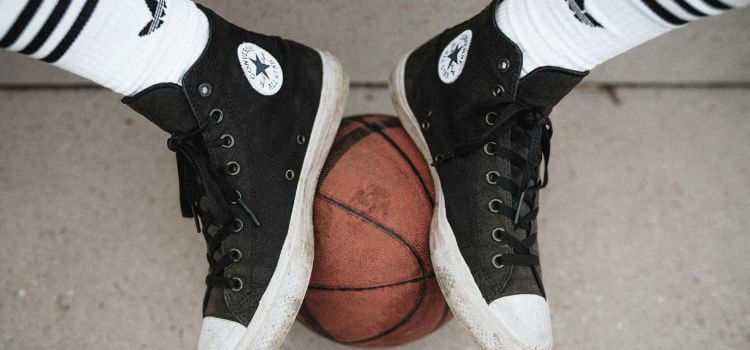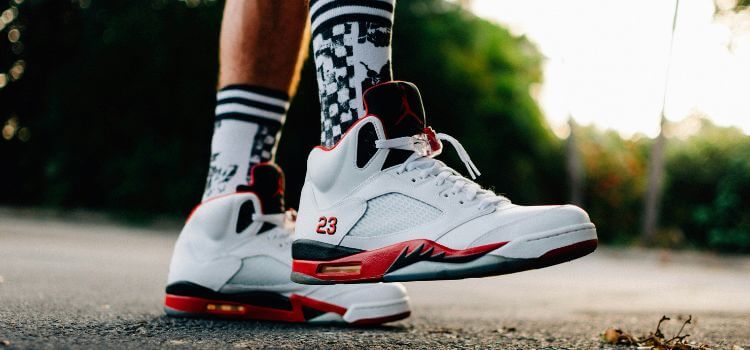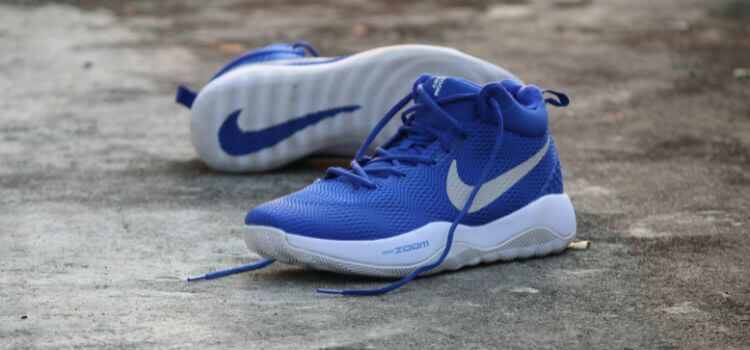Basketball shoes typically last 3-12 months with regular use. Factors like playing frequency, style, and care affect lifespan.
Choosing the right basketball shoes can significantly improve your game and foot health. These specialized sneakers provide the support, grip, and comfort necessary for the swift movements and jumps common in basketball. However, like any athletic footwear, basketball shoes have a limited lifespan, subject to the intensity and frequency of play.

Regular players might find their shoes worn out in a few months, while occasional athletes could stretch their shoe life to a year or more. Caring for your boots by cleaning them and wearing them only on the court can extend their durability. Keep in mind that the materials and construction of the shoe also influence its durability, with higher quality pairs often offering longer service. It’s crucial to monitor your shoes for signs of wear and tear to maintain peak performance and prevent injury.
Life Span Of Basketball Shoes
The life span of basketball shoes can vary widely. Every player wants to know how long their shoes will last before they need to lace up a new pair. Let’s jump into the factors that play a role in the durability of basketball shoes and what you can expect from your kicks over time.
Factors That Affect Durability
Different elements dictate how long basketball shoes will hold up:
- Material Quality: Higher quality materials can improve lifespan.
- Playing Surface: Rough courts allow shoes to wear out faster.
- Frequency of Use: Daily play reduces shoe life.
- Player Movement: Aggressive styles increase wear and tear.
- Maintenance: Regular cleaning and care help longevity.
- Fit: Well-fitting shoes are subject to less stress.
- Storage: Proper storage can prevent material degradation.
Average Length Of Service
On average, a pair of basketball shoes may last:
| Usage | Time |
| Light | One year or more |
| Moderate | 6 to 12 months |
| Heavy | 3 to 6 months |
The average length of service for basketball shoes serves as a guideline. Proper care can extend life, while extreme conditions might shorten it.
Identifying Wear And Tear
Identifying Wear and Tear on basketball shoes is crucial for performance and safety. These dynamic kicks take a beating on the court, enduring jumps, sprints, and sudden stops. Recognizing the signs of wear is essential to stay on top of your game and avoid injury. Let’s explore the indicators of shoe deterioration and the risks of persisting with worn-out sneakers.
Common Signs Of Deterioration
- Tread fading on the sole, reducing grip.
- Visible creases or folds in the midsole.
- Separation of the sole from the shoe’s upper.
- Diminished shock absorption, leading to discomfort.
- The sides or toe area shows extensive wear or holes.
- Insides are worn, with insole padding breaking down.
Safety Risks Of Worn-out Footwear
| Risk | Description |
| Ankle injuries | Weak support increases sprain risk. |
| Slipping | Worn treads lead to falls. |
| Stress Fractures | Less cushioning harms feet. |
| Back Pain | Poor sole support affects posture. |
Properly maintained basketball shoes last longer and protect players from injuries. Check your footwear regularly and replace it when it shows signs of serious wear. Your safety and performance depend on it.
Material Matters
Knowing what goes into your basketball shoes is key to understanding their lifespan. Different materials affect both durability and performance. High-quality materials might mean a higher price tag, but they often translate to longer-lasting footwear. Less durable materials may save money upfront but tend to wear out faster. Let’s break down the material influence.

Influence Of Shoe Construction
Shoe construction plays a pivotal role in a shoe’s life. A well-constructed basketball shoe withstands intense play, providing lasting support and comfort. Makers use various methods to craft these shoes, and each method impacts how long the shoes will last. Stitching, gluing, and the type of material used play critical roles.
Pros And Cons Of Different Material
Diverse materials offer specific benefits and drawbacks. Here, we’ll explore the most common materials used for basketball shoes:
- Leather:
- Pros:
- Durable
- Supportive
- Time-tested
- Cons:
- Heavier
- Less breathable
- Longer break-in period
- Synthetics:
- Pros:
- Lightweight
- Versatile designs
- More breathable
- Cons:
- Wear out faster
- Less sustainable
- Mesh:
- Pros:
- Ultra-lightweight
- Maximum breathability
- Flexibility
- Cons:
- Less durable
- Provide less support
Understanding these pros and cons helps players pick the right shoes. The material choice should resonate with their playing style, frequency, and court type. Wise decisions extend the life of basketball shoes.
Usage Intensity’s Impact
The lifespan of basketball shoes can vary greatly, and Usage Intensity plays a crucial role. How often and how hard you play influences the condition and durability of your basketball sneakers. Let’s explore how the intensity of usage affects the longevity of basketball shoes.
Effect Of Playing Frequency
The more frequently you play, the quicker your shoes will wear out. High-intensity games increase the strain on your basketball shoes. Consider these points:
- Daily players might see their shoes last a few months.
- Weekly players could use their shoes for six months to a year.
Shoe materials stretch and outsoles thin with regular use. Foam and cushioning features can degrade, impacting performance and foot support.
Professional Versus Casual Play
Only some basketball players wear shoes the same way. The difference is stark between professional and casual play.
| Professional Play | Casual Play |
| Intense daily training. High-impact moves. Shoes could last a season or less. | Less frequent games. Lower intensity. Shoes may last over a year. |
Professionals need optimal performance from their footwear, often leading to more frequent replacements. Casual players may find their shoes remain comfortable and supportive for longer periods, even with noticeable wear.
Maintenance Tips
Maintaining basketball shoes can help them last longer. Careful cleaning and storage are key. Follow these tips to keep shoes in top shape.
Cleaning Best Practices
Keep basketball shoes clean to extend their life. Here’s how:
- Remove dirt right after playing. Use a soft brush for the best results.
- For inner soles, wipe with a damp cloth and air dry.
- Avoid washing machines. Hand wash with mild soap and water instead.
- Dry shoes naturally. Never use a dryer or direct heat.
Storage Guidelines For Longevity
Proper storage keeps shoes in game-ready shape. Follow these guidelines:
- Avoid damp areas. Store shoes in a dry, cool place.
- Use a shoe rack or organizer to prevent deformation.
- Insert shoe trees or paper to retain shape.
- Keep them away from direct sunlight to anticipate fading.
The Role Of Playing Surfaces
The lifespan of basketball shoes can significantly vary depending on where you play. Different playing surfaces affect how quickly your shoes wear out. Let’s explore how different courts impact your basketball shoes.
Indoor Versus Outdoor Courts
Indoor basketball courts often feature polished wood or synthetic surfaces. These surfaces are gentler on shoes, leading to less abrasion and slower wear. Conversely, outdoor courts are rougher. Asphalt or concrete surfaces speed up the wear and tear on basketball shoes’ soles and uppers. Players frequenting outdoor courts might notice a need for new shoes more quickly.
Surface Materials And Shoe Wear
Different materials used for court surfaces can either extend or decrease the lifespan of your basketball shoes:
- Hardwood: Provides a smooth, consistent surface, lessening shoe damage.
- Asphalt: A hard, abrasive material causing increased wear.
- Composite Rubber: Often used for indoor courts, it is soft and reduces shoe deterioration.
- Concrete: Similar to asphalt, it is rough and adversely affects shoe longevity.
Dedicated basketball shoes for each playing surface prolong the life of your shoes. It is best to use separate shoes for indoor and outdoor games.
Remember, the right type of shoe for the right court makes all the difference. Keep this in mind to get the most out of your basketball shoes.
When To Replace Your Shoes
Identifying the right time to replace basketball shoes is key to maintaining top performance and foot health. Like tires on a car, shoes have a performance lifespan, and knowing when they have reached their limit is essential.

Performance Drop
Basketball shoes lose their edge as they wear down. The once sturdy grip begins to falter, and the responsive cushioning starts to flatten. Players might need more traction on the court. This can lead to slipping and reduced agility.
The midsole is crucial for shock absorption. When it’s compacted, you may feel more impact with each jump. A performance drop is a clear signal your shoes no longer offer the necessary support or efficiency.
Foot Health
Worn-out shoes can also lead to foot and ankle injuries. Without proper cushioning and stability, the risk of injury increases. Discomfort or pain while playing can be a sign. It’s crucial to protect your feet with shoes that provide adequate support.
Telltale Signs For Replacement
- Worn outsoles: Smooth patches or reduced tread pattern.
- Sides of shoes: If the sides show severe wear or start to bulge.
- Midsole compression: Check for creases or a squishy feeling.
- Interior cushioning: Look for flattened padding around the ankle.
Any of these issues merit shoe replacement. Regular assessments ensure you play your best game with minimal injury risk.
Future Of Durability
Basketball shoes are getting tougher, better, and lasting longer than ever. Players want kicks that can keep up with their game, day after day and year after year.
Advancements In Shoe Technology
Innovations in shoe tech are changing the game for athletes. Materials are stronger, lighter, and more adaptable. Think about soles that rebound like new, even after hundreds of games. We see space-age synthetics that resist wear and tear like no leather ever could.
- High-performance insoles for extra bounce
- Self-healing fabrics
- Smart tech to track wear-and-tear
Adaptive fits ensure the shoe snugs your foot just right every game, reducing stress on materials. With customized support, shoes retain their shape and function longer than before.
The Eco-friendly Movement
The green wave is hitting the court with a slam dunk. Eco-friendly doesn’t just mean biodegradable anymore; it’s about long-lasting, sustainable footwear.
| Materials | Benefit | Life Span |
| Recycled Fabrics | Reduce waste | Extended wear |
| Natural Rubbers | Lower environmental impact | Durable soles |
| Plant-Based Foams | Renewable resources | Comfy for years |
Shoes crafted from upcycled plastics and other renewable resources are not just trendy; they’re built to last.
Companies are ensuring that durability also means less pollution. They design shoes that can be recycled, making a new pair from the old.
- Buy, wear, recycle, repeat.
- Use less, play more.
- Quality shoes, cleaner planet.
Making The Right Choice
Your basketball shoes impact your game and your wallet over time. Several factors can cause shoes to wear out quickly or last longer. Making an educated choice when purchasing basketball shoes is crucial. It’s about finding a balance between durability, performance, and price. Choose wisely to save money and maintain your edge on the court.
Selecting Long-lasting Basketball Shoes
When picking basketball shoes, longevity is key. Here’s what to look for:
- Material Quality: Shoes made with premium materials endure more games.
- Shoe Design: A well-designed shoe can offer better long-term support.
- Traction Patterns: Look for shoes with strong, deep treads for extended use.
- User Reviews: Research feedback from other players about shoe lifespan.
Cost Versus Quality In The Long Run
Investing in quality pays off. Cheap shoes might save money now, but higher-quality pairs often last longer. Check this comparison:
| Shoe Type | Initial Cost | Estimated Lifespan | Cost per Month |
| Basic | $60 | months | $10 |
| Premium | $120 | 12+ months | < $10 |
Paying more upfront for quality might mean spending less over time. It ensures performance doesn’t drop as shoes age.
Personal Stories
Welcome to the Personal Stories part of our exploration into basketball shoe longevity. Real-life experiences offer valuable insights. We will hear from athletes and customers. They share their basketball shoe journeys with us.
Athletes’ Experiences
Pro and amateur athletes have demanding routines. Their shoes face intense workouts and games.
- Michael, a semi-pro player, reported his shoes lasted one season.
- Emma, a college guard, noticed performance dips after six months.
Key takeaways show training intensity and court surface affect shoe lifespan.
Customer Reviews And Feedback
Customer opinions shed light on the everyday use of basketball shoes.
| User | Shoe Model | Duration | Satisfaction Level |
| Alex | Air Dunkers | 12 months | High |
| Riley | Zoom Fly | 8 months | Medium |
Patterns emerge from reviews. High-end models tend to last longer. Good care can extend shoe life.
Frequently Asked Questions For How Long Do Basketball Shoes Last
How Often Do Basketball Shoes Need To Be Replaced?
Basketball shoes should generally be replaced every 3 to 6 months, depending on usage intensity and signs of wear. For casual players, replacing them once the treads fade or support lessens is crucial for performance and safety.
When Should You Throw Out Basketball Shoes?
Dispose of basketball shoes when they show significant sole wear, have diminished support, exhibit upper damage, or cause discomfort. Replace them every 3-6 months if used frequently.
How Do You Know When You Need New Basketball Shoes?
You need new basketball shoes if the treads are worn, the cushioning feels flat, the shoes fit poorly, or the materials show significant damage. Regular players should consider replacing them every 3-6 months.
How Often Do Basketball Players Get New Shoes?
Professional basketball players often receive new shoes every 7-10 days or about every 3-4 games, depending on wear and performance needs.
Conclusion
Wrapping up, the lifespan of your basketball shoes hinges on play intensity and care routine. Preserve them with proper maintenance, and they’ll offer support for numerous games. Remember, replacing shoes at the right time is crucial to peak performance and injury prevention.
Keep your game strong and your feet secure with the right footwear.
Related posts:
- Can Basketball Shoes Be Used For Running
- Are Basketball Shoes Slip-Resistant
- How Many Inches Do Basketball Shoes Add
- Are Volleyball Shoes & Basketball Shoes The Same
- Can You Wear Basketball Shoes Casually
- Are Basketball Shoes Good For Walking
- How To Make Your Basketball Shoes Have More Grip
- Why Do Basketball Players Wipe Their Shoes
- Are Basketball Shoes Supposed To Be Tight
